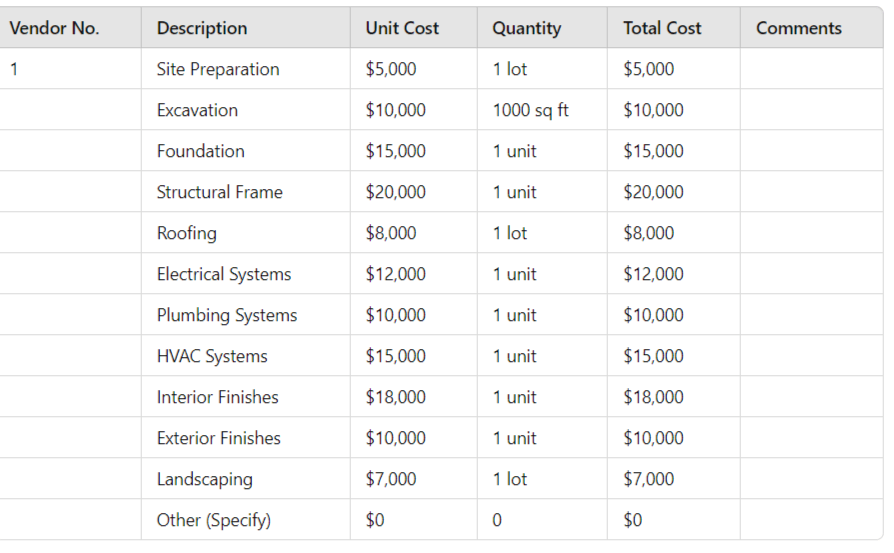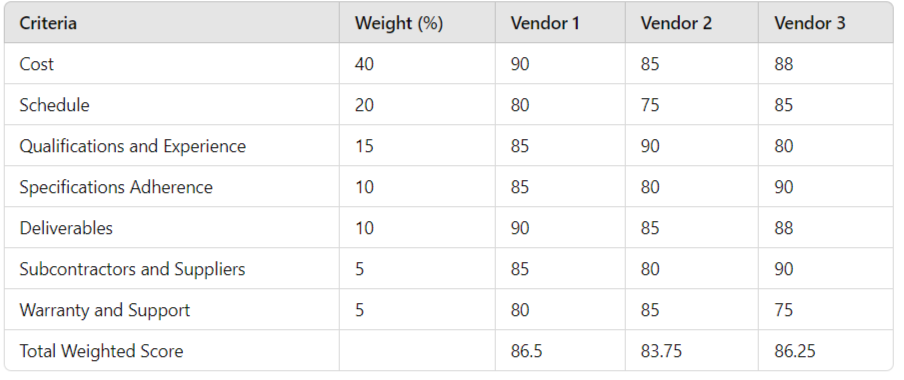If awarding construction bids was as simple as picking the lowest price, your job would be a breeze. But any experienced general contractor knows the pitfalls of choosing the cheapest option. You might get a sweet deal upfront, but the hidden costs can quickly add up – costly change orders, lengthy contract negotiations, schedule overruns, and many more.
That's why it's often wise to look for the best value rather than just the best price, and this means assesing bids to find the perfect balance of quality, cost, and efficiency. One effective way to achieve this is through bid tabulation. Bid tabulation involves collecting and organizing bids from vendors and contractors, allowing you to compare them side-by-side. It provides a clear overview of how each bid stacks up against your project's requirements.
In this guide, we'll provide you with a user-friendly bid tabulation template to streamline the process, so you won't have to start from scratch every time.
Note: Before you start sorting through bids using the template, you have to make sure you're getting bids from the right subcontractors in the first place/
Key Takeaways
- Bid tabulation compares contractor bids side-by-side to find best value beyond lowest price.
- Template includes contractor details, cost breakdowns, weighted scoring for evaluation.
- Process: calculate costs, summarize evaluations, consider qualitative factors like responsiveness.
- Clear scope of work essential for comparable bids and accurate evaluation.
- Downtobid automates with personalized ITBs achieving 30%+ response rates.
Our platform, DowntoBid, takes the hassle out of subcontractor selection by cherry-picking the most qualified, local subs to match your project requirements. The AI scans your project plans to identify potential scopes and requirements and then matches your project with the most qualified subs from our extensive database. Give it a try for free today.
How to Use the Bid Tabulation Template
A typical bid tabulation can include:
- Vendor or contractor's name
- Bid amounts
- Description of work or products offered by each bidder
- Deadlines and timelines
- Terms of the bid
- Outlined scope of work and specifications
- Any other relevant information to help compare the bids
- Additional notes or change orders relevant to each bid proposal
This template compiles these details in a uniform format, so you can make sure that all the project requirements are covered and spot price discrepancies, scope variances, and any missing items that could impact project feasibility or cost.
That said, here are a few things you should keep in mind when using this template, which you can make a copy for free here.
Meaning Of Bid Tabulation
Bid tabulation in construction is the process of collecting, organizing, and comparing contractor bids for a project. It’s a no-nonsense table breaking down each bidder’s costs, line items, and scope—straight-up numbers for straight-up comparison. It ensures bids match the specs, reveals the lowest or best-value offer, and keeps everything transparent. Just facts to control costs and pick the winner.
Include Key Contractor Details
You'll likely have multiple interactions with bidders throughout the bidding and evaluation stages. You can use this section to keep track of any significant communications. For example, note down if a bidder calls to clarify a project detail or submits a revised bid.

We've also included an optional section to track whether each bidder has acknowledged any addendums issued during the bidding process. Addendums are crucial they contain changes or additions to the original bid documents that could impact the scope, cost, or timeline of the project.
Calculate Total Costs
This section provides insight into how much each bidder is proposing to spend on every aspect of the project.
You can break down construction costs by either:
- Unit Cost: Per square foot, linear foot, cubic yard, etc., depending on the nature of the work.
- Quantity: Specify the quantity of units required for each component. This information can come from project specifications or estimates provided by the bidder.
While a lower total bid amount may initially catch your eye, you need to consider the overall value proposition offered by each bidder. Ensure that the breakdown covers all major components of the project and aligns with the project specifications. Assess the quality, scope, and completeness of the work proposed. Missing components may need to be addressed separately to avoid misunderstandings later in the project lifecycle.

If bidders offer any alternate proposals or forms, take note of them in the comments section for further consideration.
Summarize and Evaluate
Now it's time to bring everything together and make an informed decision -- you'll need to consider what matters most for your project's success. A simple technique you can use is assigning each aspect a score considering your project's priorities.
For example, if you need to stick to a tight project budget, you might give greater weight to cost than other factors such as quality, service, or timeliness. Score each part and then add them up to find the bidder that ticks the most boxes for you. The one with the highest total score is probably the best fit.

Even though the total score gives you a straightforward way to compare and manage bids, you shouldn't overlook qualitative factors that may impact the project's success. These are the things you can't put a number on, like:
- How responsive and collaborative the bidder is, and how they communicate throughout the project's lifecycle.
- Their capacity to adapt to changes, solve problems, and overcome challenges that may, naturally, arise.
- Their track record of delivering services on time and within budget, as well as feedback from previous clients.
These things may not fit neatly into your weighted scoring system, but they are equally important when picking bidders who are not just good on paper, but a good fit for your project.
Create a Comprehensive Scope of Work
While this might not directly relate to the bid tabulation template, creating a clear scope of work is crucial in the overall bid evaluation process.
What you might know is that the evaluation process starts long before any bids land on your desk. It starts with how you create your scope of work from construction drawings and specifications.
The clarity and detail of your scope of work will directly impact the quality and relevance of the bids you receive. Without a granular, detailed scope of work, evaluating bids becomes a bit like comparing apples to oranges.
Consider a vague scope of work that calls for: 'roofing for a residential home.' Each contractor might interpret the requirement differently, leading to varying bid amounts and proposed methods.
On the flip side, a well-defined construction scope of work might include:
- A projected schedule
- A list of required safety personnel or insurance requirements
- An expected number of labor hours
- Specific descriptions of each task to be completed, among other things
With such a detailed scope, you can compare specific items, identify discrepancies, and ensure all project requirements are met from the bids submitted.
Thankfully, platforms like Downtobid can help you create bid packages that highlight the main elements of your construction project, giving potential contractors a clear roadmap to follow. It helps you send ITBs with clear scopes of work and makes it easier to evaluate submitted bids.
It's a win-win across the board. You receive bids that align perfectly with your project specifications, and contractors save time when they submit bids on projects they're genuinely qualified for.
Simplify Preconstruction with Downtobid
Our bid tabulation form streamlines the bidding and evaluating process, but Downtobid goes even further in lightening your workload.
For instance, creating and sending ITBs from scratch can be a headache for most general contractors. It's time-consuming and takes focus away from other critical pre-construction tasks. To make matters worse, most existing platforms only offer cookie-cutter ITBs that often end up buried in subs' overflowing inboxes.
But with our platform, you're not just accessing a pool of local, qualified subcontractors. You're engaging them with personalized ITBs that address them by name, acknowledge their expertise, and provide all the key details about your project upfront. This way, you increase your chances of getting a response, and in return, receiving competitive bids from multiple contractors.
The results have been very promising so far. Users have reported an impressive 30%+ response rate from targeted subcontractors, with one even achieving a staggering 60% response rate and receiving over 80 bid responses using our personalized invitations. Want to experience similar results? Try Downtobid for free today.